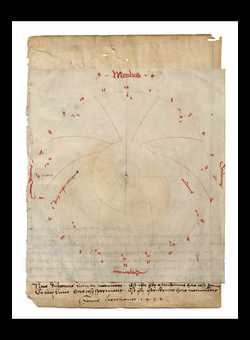Mater
The mater and limb are of other construction.
The mater is a piece of vellum that has been pasted to a
piece of paper. The paper extends below the vellum and bears
a short inscription. Scales on the limb:
| Range & Units |
Numbered |
Geometry |
Location |
| Equal
hours |
1 - 12 Times of day |
Every hour in red ink hours |
Circular, concentric |
outer |
The limb is inscribed:
| Translation |
Notes |
Type |
| Meridies |
North |
Written in red ink |
Direction |
| Occidens |
West |
Written in red ink |
Direction |
| Septentrio |
South |
Written in red ink |
Direction |
| Oriens |
East |
Written in red ink |
Direction |
| Nota distantia lune in nativitate. Est ipse gradus
ascendentis hora casus spermatis |
Note the place of the moon at the birth. That is the
degree of the ascendent at the time of conception |
|
Miscellaneous |
| Et locus lune hora casus spermatis. Est gradus
ascendentis hora nativitatis |
And the location of the moon at the moment of
conception is the degree of the ascendent at the time of
birth. |
|
Miscellaneous |
| Hans Herghamer 1492 |
|
|
Maker's signature |
Womb
The
womb of the
instrument is simply the single sheet of vellum.
Lines
| Type |
Labelled |
Description |
| Horoscopic (great) houses |
Numbered with a superscript 'a' (Numbers in
Numbers, written script) |
(Modern), Plain line style. |
| Meridian line |
|
|
| Horizon rectus |
rectus (Latin in Handwriting script) |
|
| Horizon obliquus |
'orison obliquus' on the left and 'occidens' on th
(Latin in Handwriting script) |
|
